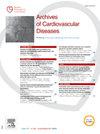Impact of high intensity and long duration exercise in genetic arrhythmogenic left ventricular cardiomyopathy
IF 2.3
3区 医学
Q2 CARDIAC & CARDIOVASCULAR SYSTEMS
引用次数: 0
Abstract
Introduction
Arrhythmogenic left ventricular (LV) cardiomyopathy (ALVC) is a genetic disease associating extensive LV myocardial fibrosis with or without dysfunction and no or mild right ventricle (RV) involvement, at risk of life-threatening ventricular arrhythmias (VA). While high intensity (HI) and long duration (LD) exercise have been identified as risk factors of RV dysfunction and VA in arrhythmogenic RV cardiomyopathy including in asymptomatic genetic variant carriers, the impact of exercise on disease phenotype and risk is not known in ALVC.
Objective
To study the relationship between practicing HI and LD exercise and the risk of developing an ALVC phenotype and its severity.
Method
In a retrospective observational study, patients with a pathogenic variant in common ALVC genes (DSP, FLNC, DES, RBM20), including asymptomatic carriers, were interviewed about their physical practice from age 7 to the time of genetic or disease diagnosis. HI and LD exercise were defined as having practiced at least 1 sport with an intensity ≥ 6 METs and ≥ 2.5 hours/week respectively. We studied the association of HI and LD exercise practice with the risk of ALVC phenotype occurrence and its severity.
Results
114 out of 128 eligible patients were included (85 (74.6%) with a DSP variant, 22 FLNC (19.3%), 6 DES (5.3%), 1 RBM20 (0.9%)). 35 were probands (31%) and 79 relatives (69%) among 46 families. 31 (27%) had no ALVC phenotype at the time of genetic diagnosis. Mean age at diagnosis was 41 ± 18. 62 (54%) patients were women. 97 (85%) had practiced at least one sport, among which 81 (83.5%) at HI and 79 (81.4%) of LD. There were no differences in HI and LD exercise practice between probands and relatives (74.3% vs 69.6%, P = 0.6 and 74.3% vs 67.1%, P = 0.4 respectively), as well as between patients with and patients without ALVC phenotype at the time of diagnosis (74.7% vs 61.3%, P = 0.2 and 72.3% vs 61.3%, P = 0.3 respectively). Phenotypic features at diagnosis did not differ between patients with and without HI and LD practice (Table 1). Multivariate analysis adjusted on age and gender showed that HI and LD exercise were not significantly associated with an increased risk of developing an ALVC phenotype (OR [95% CI] for HI and LD exercise were 2.15 [0.63; 7.27] (P = 0.22) and 1.17 [0.35; 3.87] (P = 0.79) respectively).
Conclusion
Practicing HI and LD exercise was not associated with an increased risk of developing an ALVC phenotype and its severity at the time of diagnosis in genetic ALVC variant carriers.
求助全文
约1分钟内获得全文
求助全文
来源期刊

Archives of Cardiovascular Diseases
医学-心血管系统
CiteScore
4.40
自引率
6.70%
发文量
87
审稿时长
34 days
期刊介绍:
The Journal publishes original peer-reviewed clinical and research articles, epidemiological studies, new methodological clinical approaches, review articles and editorials. Topics covered include coronary artery and valve diseases, interventional and pediatric cardiology, cardiovascular surgery, cardiomyopathy and heart failure, arrhythmias and stimulation, cardiovascular imaging, vascular medicine and hypertension, epidemiology and risk factors, and large multicenter studies. Archives of Cardiovascular Diseases also publishes abstracts of papers presented at the annual sessions of the Journées Européennes de la Société Française de Cardiologie and the guidelines edited by the French Society of Cardiology.
 求助内容:
求助内容: 应助结果提醒方式:
应助结果提醒方式:


